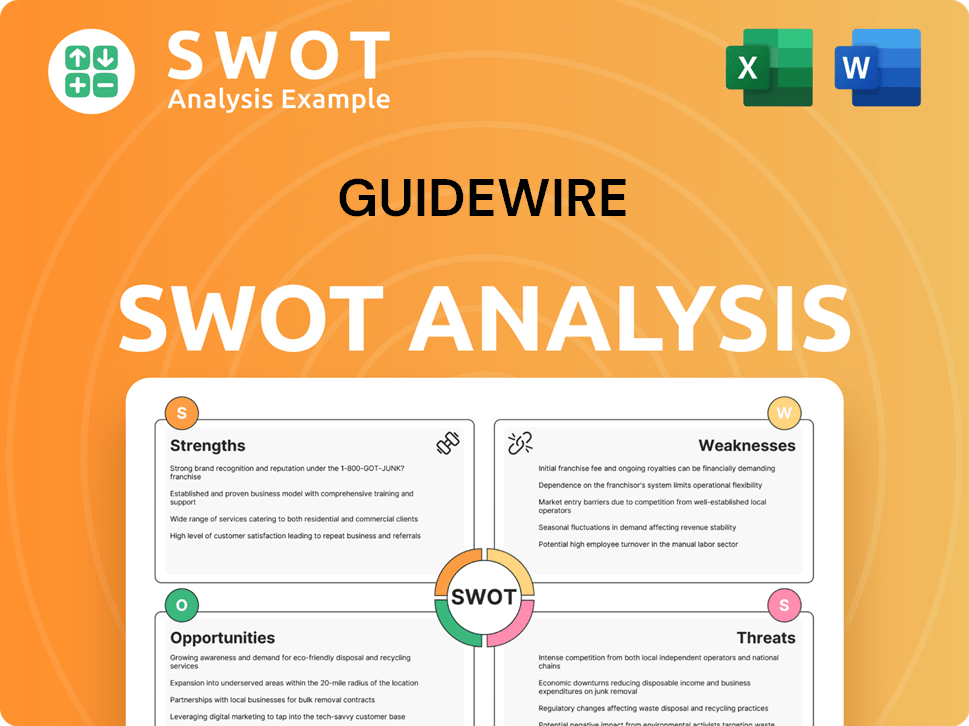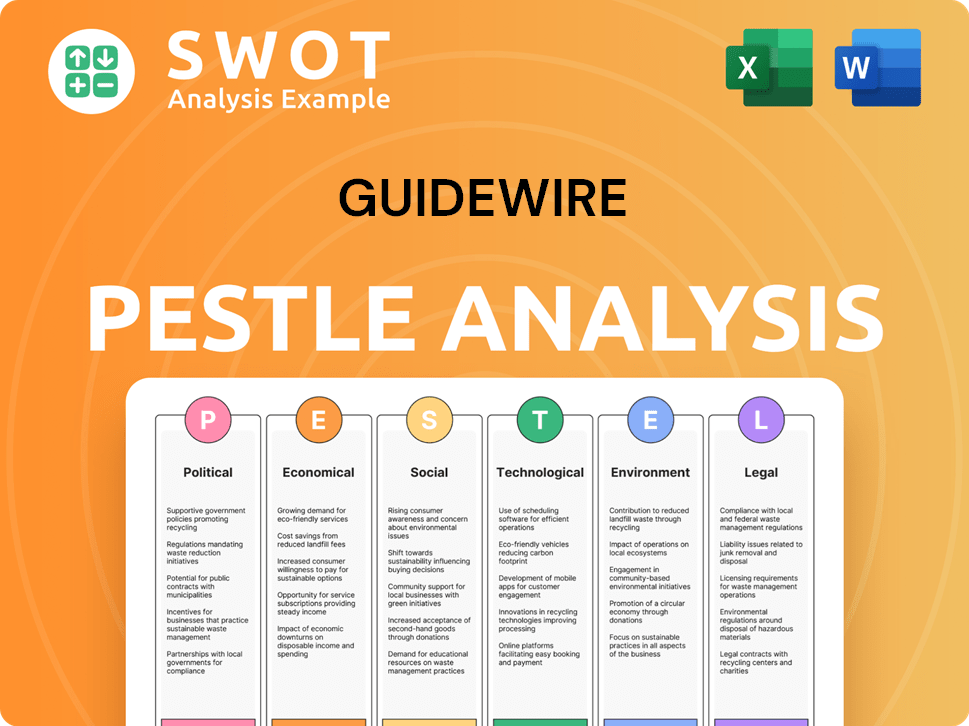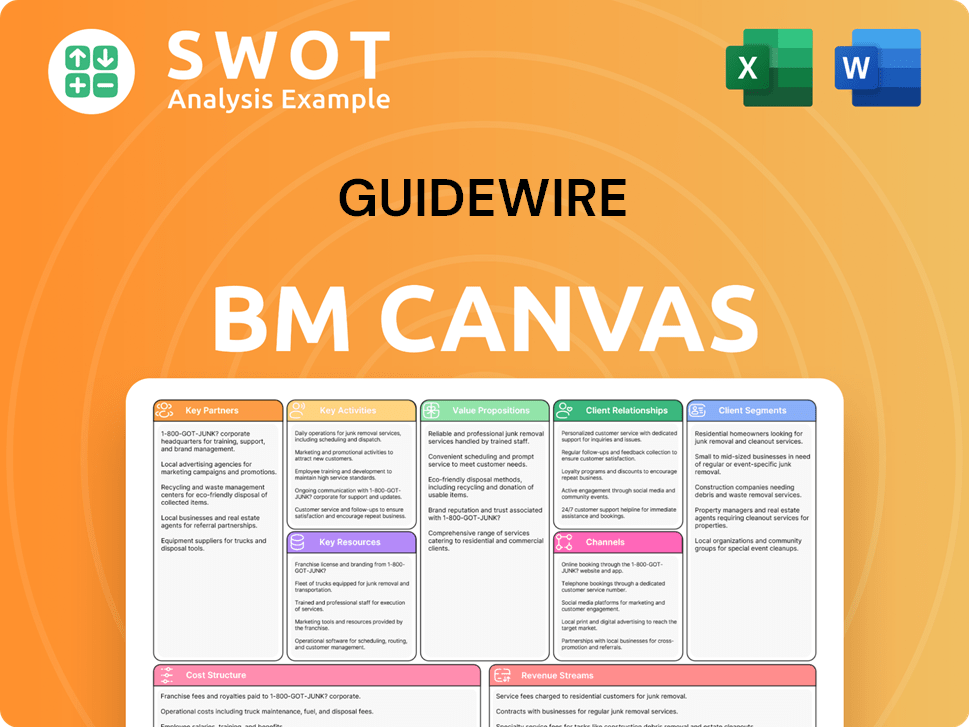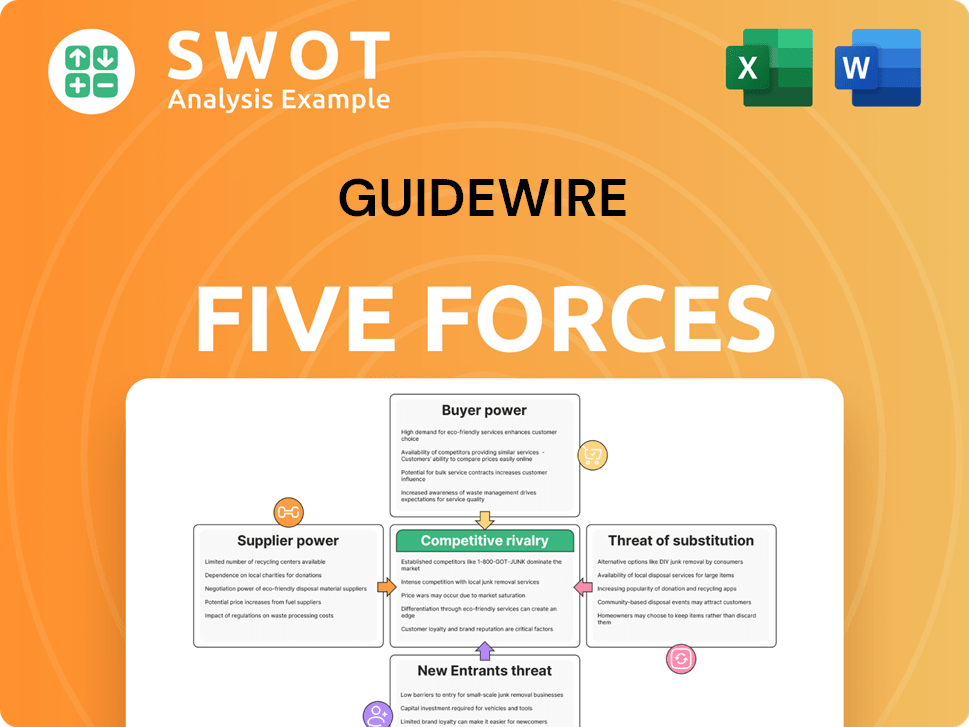Guidewire Bundle
Who Really Controls Guidewire?
Understanding a company's ownership is like deciphering its DNA, revealing its future trajectory and strategic priorities. For a tech innovator like Guidewire, a deep dive into its ownership structure unlocks crucial insights into its market influence and long-term vision. This exploration will uncover the key players shaping the destiny of Guidewire SWOT Analysis, a leading force in the insurance technology sector.

As a publicly traded entity, understanding the current composition of Guidewire ownership is key to investors and stakeholders. This analysis will examine the evolution of Guidewire Technologies, from its founding to its current status, identifying the major Guidewire investors and their impact on the company's direction. We will explore the influence of institutional shareholders and individual investors on the Guidewire stock and its overall financial performance.
Who Founded Guidewire?
The story of Guidewire Technologies began in 2001 with a vision to modernize the property and casualty (P&C) insurance industry. The company's foundation was laid by Ken Branson, John Raguin, and Marcus Ryu, each bringing unique skills to the table. Their combined expertise in technology, sales, and strategic leadership set the stage for Guidewire's future growth and success.
The founders aimed to address the inefficiencies of outdated IT systems common in the insurance sector. This focus on innovation and a deep understanding of the industry's needs allowed Guidewire to develop software solutions tailored to the specific challenges faced by P&C insurers. This strategic approach was crucial in attracting early investors and establishing a strong market presence.
Early on, Guidewire secured backing from venture capital firms, which is typical for tech startups. While specific details of initial equity splits are not publicly available, venture capital played a vital role in funding product development and market expansion. These early investments were structured to align the interests of the founders and investors, driving Guidewire's long-term value creation.
Guidewire's early funding primarily came from venture capital, crucial for its initial growth. The ownership structure was designed to align the interests of founders and early investors.
- The founders, Ken Branson, John Raguin, and Marcus Ryu, brought diverse expertise to the company.
- Venture capital firms provided the necessary capital for product development and market expansion.
- Early investors received equity stakes, with agreements that shaped the long-term ownership structure.
- The focus was on creating software solutions to modernize IT systems in the P&C insurance industry.
As of 2024, the company's market capitalization is substantial, reflecting its success and growth over the years. The current stock price and shareholder list are available through financial data providers, offering insights into the current Guidewire ownership structure. The company's financial performance, including annual revenue, continues to be a key indicator of its market position and the effectiveness of its strategic initiatives. The company's IPO date was in 2012, and since then, Guidewire investors have closely watched its progress.
Guidewire SWOT Analysis
- Complete SWOT Breakdown
- Fully Customizable
- Editable in Excel & Word
- Professional Formatting
- Investor-Ready Format

How Has Guidewire’s Ownership Changed Over Time?
The ownership structure of the Guidewire company has significantly evolved, particularly with its Initial Public Offering (IPO). This transition from a privately held, venture-backed entity to a publicly traded company on January 25, 2012, broadened its investor base. The IPO marked a key moment, shifting the ownership landscape and attracting a wide range of institutional and individual investors.
Since the IPO, the company's market capitalization has grown, drawing considerable investment from major institutional players. This shift has had a notable impact on the company's strategic direction, emphasizing consistent financial results, shareholder returns, and transparent governance. The influence of early investors and founders has naturally diluted over time due to the increased availability of shares and market activities.
| Event | Impact on Ownership | Date |
|---|---|---|
| Initial Funding Rounds | Venture capital and private equity ownership | Pre-2012 |
| Initial Public Offering (IPO) | Transition to public ownership, increased institutional investment | January 25, 2012 |
| Secondary Offerings | Further dilution, increased institutional holdings | Post-IPO |
As of early 2025, the major stakeholders in Guidewire primarily include large institutional investors, mutual funds, and index funds. The Vanguard Group, BlackRock, and State Street Corporation are consistently among the top institutional shareholders. For example, in the first quarter of 2025, The Vanguard Group, Inc. held approximately 11.5% of Guidewire's shares, and BlackRock, Inc. held around 9.8%. Other significant holders include T. Rowe Price Associates, Inc. and Capital Research Global Investors. These holdings reflect a trend where passive and active funds manage substantial portfolios for their clients. The shift towards institutional ownership has influenced the company's strategy, emphasizing financial performance and shareholder returns.
Guidewire's ownership structure has evolved significantly since its IPO in 2012, transitioning from private to public ownership.
- Major shareholders include institutional investors like Vanguard and BlackRock.
- Institutional ownership influences the company's strategic focus on financial performance and shareholder value.
- The IPO was a pivotal moment, opening ownership to a broader base of investors.
- The shift towards institutional ownership has influenced Guidewire's strategy.
Guidewire PESTLE Analysis
- Covers All 6 PESTLE Categories
- No Research Needed – Save Hours of Work
- Built by Experts, Trusted by Consultants
- Instant Download, Ready to Use
- 100% Editable, Fully Customizable

Who Sits on Guidewire’s Board?
The current Board of Directors of the Guidewire company plays a vital role in overseeing the company's strategic direction and governance. As of early 2025, the board includes a diverse set of individuals with expertise in technology, insurance, and finance. The board's composition reflects a mix of independent directors and those with ties to major shareholders or the company's founding. Prominent board members may include individuals with a strong background in enterprise software or the insurance industry, providing valuable strategic insights.
While specific board members may represent major institutional shareholders indirectly through their investment firm affiliations, the majority of the board typically consists of independent directors to ensure objective oversight. The board's structure is designed to uphold corporate governance best practices, ensuring accountability to its broad base of public shareholders and fostering long-term value creation. The Guidewire Technologies board's composition and the company's voting structure are designed to uphold corporate governance best practices, ensuring accountability to its broad base of public shareholders and fostering long-term value creation.
| Board Member | Title | Affiliation |
|---|---|---|
| Marcus Ryu | Chairman of the Board | Guidewire Software, Inc. |
| Mike Rosenbaum | Chief Executive Officer | Guidewire Software, Inc. |
| Scott Brown | Lead Independent Director | Former CFO, VMWare |
Guidewire ownership operates under a standard one-share-one-vote voting structure, meaning each share of common stock generally entitles its holder to one vote on matters submitted to a vote of stockholders. This structure promotes a more equitable distribution of voting power among shareholders. There have not been widely publicized recent proxy battles or activist investor campaigns that have significantly altered Guidewire's governance or decision-making processes.
The board includes a mix of independent directors and those with ties to major shareholders.
- The voting structure is one-share-one-vote, promoting equitable power distribution.
- The board's composition supports good corporate governance.
- The board oversees the strategic direction and governance of Guidewire Technologies.
- The board ensures accountability to shareholders and fosters long-term value.
Guidewire Business Model Canvas
- Complete 9-Block Business Model Canvas
- Effortlessly Communicate Your Business Strategy
- Investor-Ready BMC Format
- 100% Editable and Customizable
- Clear and Structured Layout

What Recent Changes Have Shaped Guidewire’s Ownership Landscape?
Over the past few years, the ownership landscape of Guidewire Technologies has evolved, mirroring trends within the technology and insurance sectors. The company has strategically focused on acquisitions to boost its cloud offerings and market position. For instance, the acquisition of HazardHub in 2021 aimed to enhance its data and analytics capabilities, indirectly affecting investor interest and company valuation. Leadership transitions, such as the recent CEO change, have also subtly influenced internal dynamics, though direct ownership percentages remain relatively stable.
A key trend affecting the Guidewire company is the increasing institutional ownership. As of early 2025, institutional investors continue to hold a significant portion of Guidewire's stock. This concentration often leads to greater emphasis on financial performance and corporate governance, as large institutions prioritize long-term value. While founder dilution is a natural part of being a public company, the original vision continues to influence the company's culture and strategic direction. There are no public announcements suggesting an imminent privatization or a major shift in its public listing status. Instead, the focus remains on growth, cloud adoption, and strategic partnerships within the P&C insurance ecosystem, which impacts investor sentiment and the stability of its ownership base.
Institutional investors hold a significant majority of Guidewire's stock, as of early 2025. This trend highlights the importance of long-term value and governance for institutional investors.
The acquisition of HazardHub in 2021 is an example of Guidewire Technologies enhancing its data and analytics capabilities. This impacts company valuation and investor interest.
Guidewire Porter's Five Forces Analysis
- Covers All 5 Competitive Forces in Detail
- Structured for Consultants, Students, and Founders
- 100% Editable in Microsoft Word & Excel
- Instant Digital Download – Use Immediately
- Compatible with Mac & PC – Fully Unlocked

Related Blogs
- What are Mission Vision & Core Values of Guidewire Company?
- What is Competitive Landscape of Guidewire Company?
- What is Growth Strategy and Future Prospects of Guidewire Company?
- How Does Guidewire Company Work?
- What is Sales and Marketing Strategy of Guidewire Company?
- What is Brief History of Guidewire Company?
- What is Customer Demographics and Target Market of Guidewire Company?
Disclaimer
All information, articles, and product details provided on this website are for general informational and educational purposes only. We do not claim any ownership over, nor do we intend to infringe upon, any trademarks, copyrights, logos, brand names, or other intellectual property mentioned or depicted on this site. Such intellectual property remains the property of its respective owners, and any references here are made solely for identification or informational purposes, without implying any affiliation, endorsement, or partnership.
We make no representations or warranties, express or implied, regarding the accuracy, completeness, or suitability of any content or products presented. Nothing on this website should be construed as legal, tax, investment, financial, medical, or other professional advice. In addition, no part of this site—including articles or product references—constitutes a solicitation, recommendation, endorsement, advertisement, or offer to buy or sell any securities, franchises, or other financial instruments, particularly in jurisdictions where such activity would be unlawful.
All content is of a general nature and may not address the specific circumstances of any individual or entity. It is not a substitute for professional advice or services. Any actions you take based on the information provided here are strictly at your own risk. You accept full responsibility for any decisions or outcomes arising from your use of this website and agree to release us from any liability in connection with your use of, or reliance upon, the content or products found herein.